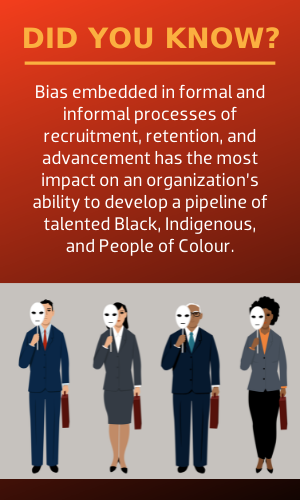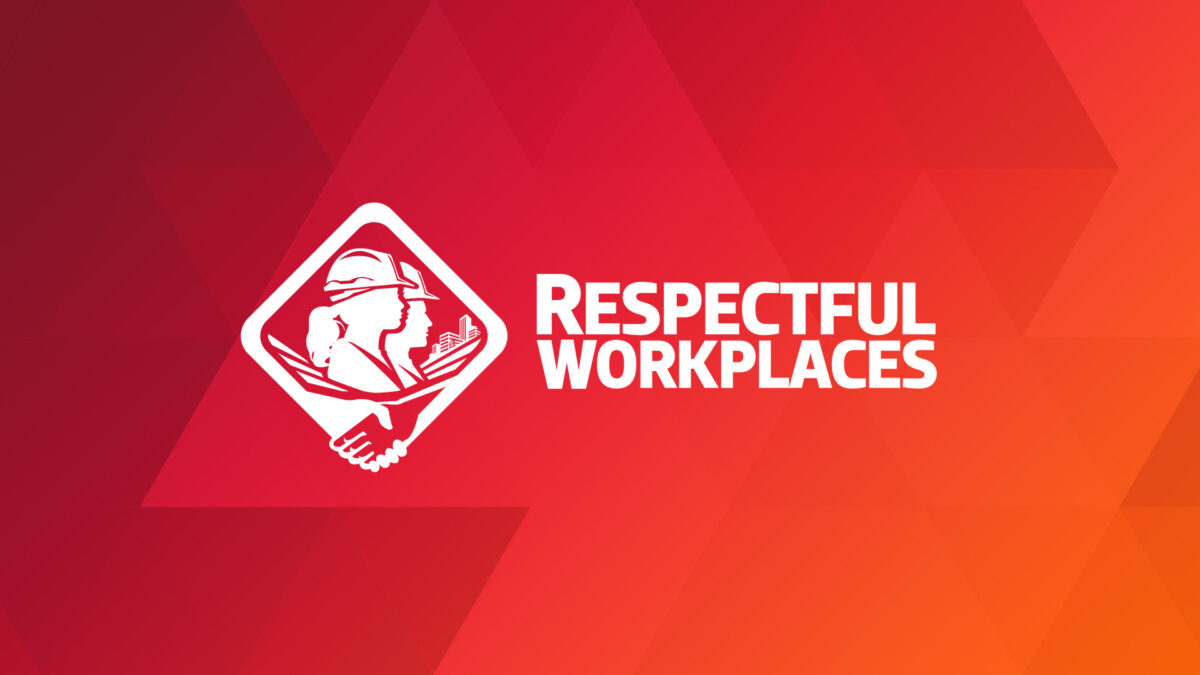Does your organization understand how bias can influence recruitment and retention systems?

Research shows that everyone has biases. Awareness of our own biases and efforts to interrupt them can result in better decision making and help to reduce systemic racism. However, addressing individual bias alone is not sufficient. To make sustainable change, there must be shifts at the organizational level as well.
Bias becomes systemic when it influences not just one decision, but a series of decisions. Bias embedded in formal and informal processes of recruitment, retention, and advancement has the most impact on an organization’s ability to develop a pipeline of talented Black, Indigenous, and People of Colour.
5 ways bias may be influencing systems of recruitment and retention:
1. Bias may be reflected in job descriptions.
For example, job descriptions may specify a career profile that unintentionally screens out qualified candidates. Research confirms that Black, Indigenous, and People of Colour often arrive in their careers through non-traditional routes. They tend to be overrepresented in junior positions, and as a result, they are more subject to practices such as “last in, first out,” in which those hired later are the first to be let go in situations of re-structuring.
Research also shows that Black, Indigenous, and People of Colour who are recruited for a management track, may find that they do not have the same opportunities as their white colleagues and must continue their search for career opportunities in another organization. The result is that they may have an uneven career profile.
2. Bias may also be evident in the screening process.
For example, the online career search company, Ladders, found that recruiters evaluate resumes in about 7.4 seconds. They use a few key pieces of information: the applicant’s current job title, whether there is career progression since the previous position, and unexplained gaps between positions. Meeting these criteria could be difficult for qualified candidates who have uneven career profiles.
3. Bias could be evident in the discussions when interviewers are evaluating candidates.
For example, because of affinity bias (see Blog #46), we tend to relate more easily to people who share similar backgrounds or experiences: often, we feel a higher level of comfort with those like us. This can lead managers to unconsciously express a preference for a specific candidate based on bias rather than the individual’s capability.
4. Bias may also influence the informal relationship-building and social interaction usually critical to successful career development.
For example, priming bias (see Blog #46) occurs when we are “primed” to think more highly of a person when we know that a trusted colleague thinks highly of that person. This may lead a manager to be more available and grant attention to specific individuals.
5. Bias may also be evident in performance appraisals and promotion decisions.
Research shows that managers often find it difficult to give feedback to people who are different from themselves. This dynamic has the greatest impact not in annual performance evaluations, but in the day-to-day opportunities for immediate feedback on a given situation or decision.
Systemic bias is not the result of one decision or the intentional discrimination of one person. Rather, bias becomes systemic when it affects a series of decisions throughout systems, such as recruitment and retention. Understanding how bias may be influencing the employment life cycle will help to create a more inclusive organization for talented Black, Indigenous, and People of Colour.
—
The BuildForce Respectful Workplace Online Toolkit provides three tools based on the proven practices of respectful and inclusive organizations to help address systemic racism: the Online Self-Assessment Tool, a Policy Framework and Implementation Guide, and the online course, “Working in a Respectful and Inclusive Workplace.”
The management Self-Assessment Tool provides a blueprint of the actions required to identify and re-work systems where unconscious bias may be impacting management goals to be fair and inclusive in their recruitment, promotion, and retention practices.
Also look for the new BuildForce online course, to be released late summer 2021, to help leaders and managers to understand systemic racism. BuildForce is also developing a new module for the “Working in a Respectful and Inclusive Workplace” course to help workers develop awareness about systemic racism, also to be released in 2021.
For more info:
- CoQual. “Being Black in Corporate America: An Intersectional Exploration.” 2019. See https://coqual.org/wp-content/uploads/2020/09/CoqualBeingBlackinCorporateAmerica090720-1.pdf.
- Deloitte. “The Diversity and Inclusion Revolution: Eight Powerful Truths.” January 2018. See https://www2.deloitte.com/us/en/insights/deloitte-review/issue-22/diversity-and-inclusion-at-work-eight-powerful-truths.html.
- Donovan, Mason and Mark Kaplan. “The Inclusion Dividend, 2nd Ed.” DG Press, New Hampshire, U.S., 2019.
- Lepore, Meredith. “You have 7.4 seconds to make an impression.” 2020. See https://www.theladders.com/career-advice/you-only-get-6-seconds-of-fame-make-it-count.
Read from the beginning. Click here to start at Part 1.
What can an effective Respectful and Inclusive Workplace Program deliver?
- Become an employer of choice – attract, retain, and advance top talent from all sources of labour
- Unlock collaboration and innovation – create high-performing teams through diversity of thought and experience
- Build your brand – your organization will gain a competitive edge as a leader and innovator
Get started today!
The BuildForce Canada Online Respectful and Inclusive Workplace Toolkit includes:
- the Respectful Workplace Online Self-Assessment Tool to assist organization leadership in assessing their current situation and identifying where they may need to make changes
- the Respectful Workplace Policy Framework and Implementation Guide to assist organizations in creating and implementing a policy that supports a respectful and inclusive workplace
- the Respectful Workplace Online Training Course to train workers on how to create and support a respectful and inclusive workplace
- the online course Introduction to Understanding Systemic Racism: A Guide for Leaders and Managers
All the resources you need to create and support a respectful and inclusive workplace!

Respectful and Inclusive Workplaces
